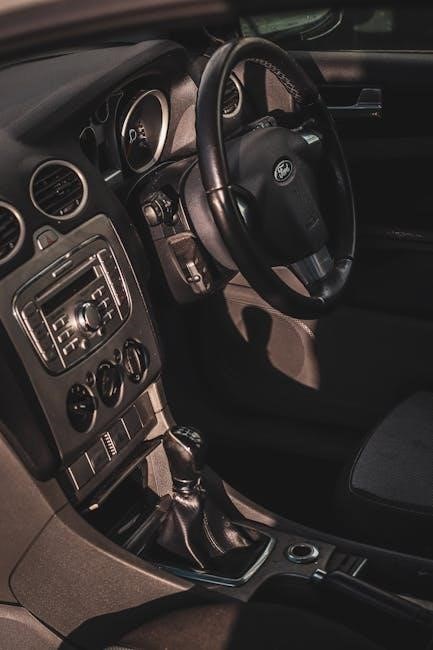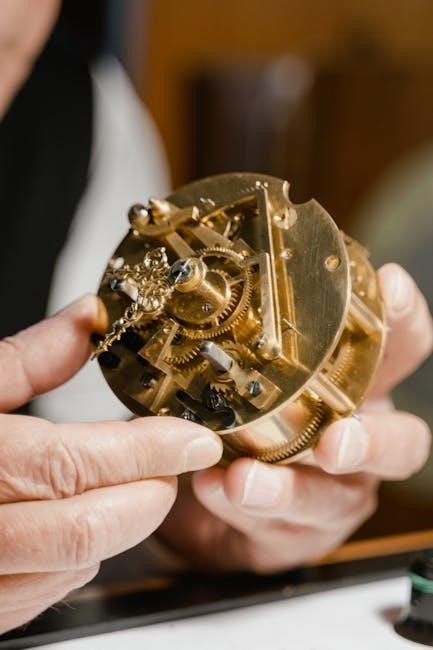The 2012 Ford Focus is a compact car designed for efficiency and performance. This manual provides essential guidance for maintenance, repairs, and understanding its systems.
1.1 Overview of the 2012 Ford Focus Model
The 2012 Ford Focus is part of the third generation (Mk3) and is available as a Hatchback or Sedan. It features a 2.0L Duratec-HE engine, known for its balance of power and fuel efficiency. The model emphasizes handling, comfort, and technology, with options like Ford SYNC and EcoMode. It also includes advanced safety features and improved emissions standards.
1.2 Importance of the Service Manual
The service manual for the 2012 Ford Focus is essential for proper maintenance, repairs, and understanding the vehicle’s systems. It provides detailed guidance on diagnosis, service procedures, and specifications, ensuring safety and efficiency. Whether for routine maintenance or complex repairs, the manual is a vital resource for both professionals and DIY enthusiasts, helping to maintain the vehicle’s performance and longevity.
General Information
This section provides essential service information and specifications for the 2012 Ford Focus, detailing key data and guidelines for proper vehicle maintenance and safe servicing practices.
2.1 Service Information and Specifications
This section outlines the service information and specifications for the 2012 Ford Focus, including torque values, fluid capacities, and technical data. It ensures accurate diagnostics, repairs, and maintenance, promoting safety and efficiency. Proper adherence to these guidelines is crucial for optimal vehicle performance and longevity. Always refer to this section before starting any service procedure to ensure compliance with manufacturer standards.
2;2 Safety Precautions and Warnings
Always adhere to safety precautions when servicing the 2012 Ford Focus. Wear protective gear, ensure the vehicle is on level ground, and disconnect the battery before starting work. Use proper tools and follow manufacturer guidelines to avoid injury or damage. Never bypass safety systems, and refer to specific warnings in this manual for critical procedures. Safety is paramount to prevent accidents and ensure effective repairs.
Engine
The 2012 Ford Focus features a 2.0L Duratec-HE engine, known for its efficiency and performance. This section covers engine specifications, diagnostics, and service procedures for optimal maintenance and repair.
3.1 Engine Types and Specifications
The 2012 Ford Focus is equipped with a 2.0L Duratec-HE engine, delivering 125kW of power. This engine features advanced fuel injection and efficiency technologies. Detailed specifications, including torque ratings and performance metrics, are outlined in this section for accurate diagnosis and maintenance. Proper service procedures ensure optimal engine functionality and longevity. Always refer to the manual for precise technical data.
3.2 Engine Service Procedures
This section outlines step-by-step engine service procedures for the 2012 Ford Focus. It covers oil changes, filter replacements, and timing belt inspections. Detailed instructions ensure proper maintenance, while torque specifications and fluid capacities are provided for accuracy. Always follow safety guidelines and use specialized tools as recommended in the manual to avoid engine damage and ensure optimal performance.

Transmission and Drivetrain
This section covers the transmission and drivetrain of the 2012 Ford Focus. It includes maintenance procedures, component inspections, and repair guidelines to ensure smooth operation and longevity.
4.1 Transmission Types and Components
The 2012 Ford Focus features a range of transmissions, including manual and automatic options. Key components include the gearbox, clutch, torque converter, and drivetrain. The automatic transmission utilizes a dual-clutch system for smooth shifting and improved performance. Proper understanding of these components is essential for efficient servicing and maintenance, ensuring optimal vehicle operation and longevity.
4.2 Drivetrain Service and Maintenance
Regular drivetrain service is crucial for the 2012 Ford Focus. This includes lubrication of drivetrain components, inspection of driveshafts, and replacement of worn parts. Proper alignment and balancing ensure smooth operation. Always use Ford-recommended lubricants and adhere to specified torque values. Addressing issues promptly prevents costly repairs and maintains optimal vehicle performance and efficiency over time.
Chassis and Suspension
The 2012 Ford Focus features a robust chassis and suspension system designed for stability and comfort. Regular inspections and replacements of worn components ensure optimal performance and safety.
5.1 Suspension System Overview
The 2012 Ford Focus suspension system is designed for stability and comfort, featuring MacPherson struts upfront and a torsion beam rear setup. Coil springs and stabilizer bars enhance ride quality. Regular inspections of components like bushings, shocks, and control arms are crucial. The manual provides detailed procedures for diagnosis, adjustments, and replacements, ensuring optimal handling and safety. Proper maintenance prevents wear and tear.
5.2 Chassis Components and Service
The 2012 Ford Focus chassis includes subframes, steering knuckles, and control arms, ensuring structural integrity. Regular inspection and tightening of bolts are essential. The manual outlines procedures for servicing chassis components, including alignment checks and replacement of worn parts. Proper torque specifications must be followed to maintain stability and safety. Regular maintenance prevents premature wear and ensures optimal performance.

Brake System
The 2012 Ford Focus brake system includes discs, pads, and calipers. Regular inspections and fluid checks ensure optimal performance and safety. Proper maintenance is crucial.
6.1 Brake Types and Components
The 2012 Ford Focus features a robust braking system with front and rear disc brakes. Components include brake pads, rotors, calipers, and a master cylinder. The system is designed for efficient heat dissipation and consistent stopping power. Proper maintenance of these parts ensures reliable performance and safety on the road, as outlined in the service manual. Regular inspections are essential.
6.2 Brake Service and Repair
Brake service for the 2012 Ford Focus involves inspecting pads, rotors, and fluid levels. Common repairs include replacing worn pads and resurfacing rotors. Bleeding the brake system is necessary when air enters the lines. Always refer to the service manual for specific torque specifications and procedures. Proper maintenance ensures optimal braking performance and safety. Regular checks are crucial to prevent premature wear and potential failures.
Steering System
The 2012 Ford Focus features an electric power steering system for improved maneuverability. Regular checks of steering components, such as sensors and fluid levels, are essential.
7.1 Steering System Components
The 2012 Ford Focus steering system includes an electric power steering motor, steering column, and rack-and-pinion assembly. Sensors monitor steering angle and torque, enhancing responsiveness. Regular inspection of these components and fluid levels ensures smooth operation and reliability. Proper maintenance of these parts is crucial for optimal vehicle handling and safety on the road.
7.2 Steering System Maintenance
Regular inspection of the steering system is crucial for optimal performance. Check the power steering fluid level and ensure no leaks. Inspect the steering column and rack-and-pinion assembly for wear. Clean sensors and ensure proper alignment. Address any unusual noise or vibration promptly. Refer to the manual for specific maintenance intervals and procedures to maintain precise handling and safety.

Electrical System
The 2012 Ford Focus electrical system powers essential components, including lights, infotainment, and safety features. The manual provides detailed wiring diagrams, diagnostic tools, and repair procedures for electrical issues.
8.1 Electrical System Overview
The 2012 Ford Focus electrical system is a critical component, powering essential features like lights, infotainment, and safety systems. The manual provides detailed wiring diagrams, circuit explanations, and diagnostic techniques. Understanding this system is vital for troubleshooting and maintaining the vehicle’s reliability and performance, ensuring all electrical components function optimally;
8.2 Common Electrical Repairs
The 2012 Ford Focus may experience electrical issues like faulty sensors, wiring harness problems, or battery drain; The manual details troubleshooting steps for these common repairs, including diagnosing faulty alternators, repairing blown fuses, and addressing wiring connections. It also provides guidance on resetting electronic systems and replacing malfunctioning components, ensuring proper functionality of the vehicle’s electrical systems.

Exterior and Interior Components
The 2012 Ford Focus features durable exterior components, including body panels and trim, designed for both functionality and style. Interior components like seats and dashboard are built for comfort and longevity, ensuring a pleasant driving experience.
9.1 Exterior Components and Maintenance
The 2012 Ford Focus exterior components include durable body panels, trim, and paint finishes. Regular maintenance involves inspecting for damage, cleaning, and protecting surfaces. Replace damaged parts promptly to prevent corrosion. Use Ford-approved products for optimal results. Follow the manual’s guidelines for proper care to maintain the vehicle’s appearance and structural integrity, ensuring long-lasting performance and reliability.
9.2 Interior Components and Adjustments
The 2012 Ford Focus interior features durable materials and ergonomic design. Regular cleaning of upholstery, carpets, and surfaces is essential. Adjustments include seat positioning, steering wheel alignment, and dashboard settings. Addressing dashboard alerts promptly ensures optimal performance. Use Ford-approved cleaning products to maintain interior quality and longevity, ensuring a comfortable and functional driving environment for years to come.

Diagnostic and Troubleshooting
The 2012 Ford Focus manual provides diagnostic tools and techniques to identify common issues. Refer to the troubleshooting guide for solutions and repair procedures safely and efficiently.
10.1 Diagnostic Tools and Techniques
The 2012 Ford Focus manual outlines essential diagnostic tools, including OBD-II scanners and Ford-specific diagnostic software. Techniques involve reading fault codes, monitoring live data, and performing system tests. Specialized tools like the Integrated Diagnostic System (IDS) are recommended for advanced troubleshooting. Visual inspections and test drives are also crucial for identifying issues accurately and efficiently, ensuring proper repairs and maintenance.
10.2 Common Issues and Solutions
Common issues with the 2012 Ford Focus include fault codes related to engine performance and transmission. Solutions involve using diagnostic tools to identify problems, such as DTCs for engine or transmission malfunctions. Coolant leaks and electrical system faults are also frequent. Repair often requires replacing faulty sensors, checking fluid levels, or updating software. Regular maintenance and inspections can prevent many of these issues from arising.

Maintenance Schedule
The 2012 Ford Focus requires regular maintenance, including oil changes, tire rotations, and fluid checks. Follow the recommended schedule for optimal performance and reliability.
11.1 Recommended Maintenance Intervals
Regular maintenance is crucial for the longevity of your 2012 Ford Focus. Key intervals include oil changes every 5,000 to 7,500 miles, tire rotations every 5,000 miles, and fluid checks every 15,000 miles. Brake pads should be inspected every 10,000 miles, while the timing belt replacement is recommended at 100,000 miles. Spark plugs should be replaced every 30,000 to 100,000 miles for optimal engine performance. Always follow the schedule outlined in your owner’s manual.
11.2 Routine Maintenance Procedures
Routine maintenance for the 2012 Ford Focus involves checking and topping off fluids, inspecting belts and hoses, and replacing the air filter every 15,000 to 30,000 miles. Battery terminals should be cleaned, and tire pressure checked monthly. Brake pads and rotors should be inspected every 10,000 miles, while spark plugs are typically replaced every 30,000 to 100,000 miles. Regular inspections ensure optimal performance and prevent costly repairs.
Repair and Overhaul
This section covers major repair procedures and rebuild guidelines for the 2012 Ford Focus, including engine, transmission, and drivetrain components, designed for experienced technicians.
12.1 Major Repair Procedures
This section provides detailed instructions for major repairs, including engine overhaul, transmission rebuild, and drivetrain replacement. It covers disassembly, inspection, and reassembly processes, ensuring precision and safety. Step-by-step guidance, torque specifications, and essential safety precautions are included to help technicians perform complex repairs effectively.
12.2 Rebuild and Assembly Guidelines
This section outlines detailed procedures for rebuilding and assembling components, ensuring proper alignment and precision. It covers inspection of parts, use of specialized tools, and adherence to torque specifications. The manual emphasizes a systematic approach to reassembly, with step-by-step instructions and detailed diagrams to ensure reliability and performance. Proper alignment and precision are critical to prevent future issues.
Tools and Equipment
This section lists essential tools and equipment required for servicing the 2012 Ford Focus. It includes specialized tools and adapters needed for specific procedures, ensuring accuracy and safety.
13.1 Essential Tools for Servicing
The 2012 Ford Focus servicing requires specific tools for efficiency. A torque wrench, socket set, screwdrivers, pliers, and wrenches are essential. Specialized tools like the torque wrench adapter ensure accurate adjustments. These tools help in diagnosing and performing repairs safely, adhering to factory specifications, and maintaining the vehicle’s performance. Proper equipment is crucial for both basic and advanced service procedures.
13.2 Specialized Equipment Requirements
Servicing the 2012 Ford Focus may require specialized equipment for complex tasks. Diagnostic tools like scan tools and multimeters are necessary for troubleshooting electrical systems. Hydraulic lifts and wheel alignment machines are essential for suspension and brake services. Air compressors and precision measuring tools also aid in accurate repairs. These tools ensure compliance with factory standards and efficient servicing.

Torque Specifications
The 2012 Ford Focus manual provides detailed torque specifications for bolts and fasteners. Proper torque values ensure safe and reliable servicing, preventing component damage.
14.1 General Torque Values
The 2012 Ford Focus manual outlines general torque specifications for various components. Engine bolts, suspension parts, and drivetrain components have specific torque values to ensure proper assembly. For example, cylinder head bolts may require 30-40 Nm, while wheel nuts typically need 100-120 Nm. Always refer to the manual for precise values to avoid damage or safety hazards during servicing. Proper torque ensures reliability and longevity of vehicle components.
14.2 Specific Component Torque Specifications
The 2012 Ford Focus manual provides detailed torque values for specific components. Engine mounts require 40-50 Nm, while suspension bolts typically need 60-70 Nm. Drivetrain components, such as axle nuts, may require 100-120 Nm. Proper torque ensures secure connections and prevents damage. Always consult the manual for accurate specs, as values vary by component and application. Adhering to these limits is crucial for safety and performance.

Fluids and Lubricants
The 2012 Ford Focus manual specifies essential fluids and lubricants for optimal performance. Use recommended engine oil, coolant, transmission, and brake fluid to ensure longevity and prevent damage.
15.1 Recommended Fluid Types
The 2012 Ford Focus manual specifies using high-quality fluids to maintain performance. Engine oil should meet Ford’s WSS-M2C929-A specifications. Use a 50/50 coolant mix of ethylene glycol and water. Transmission fluid must be Ford’s MERCON® LV. Brake fluid should be DOT 4. Proper fluids ensure optimal vehicle operation and longevity, preventing damage to critical systems. Always refer to the manual for exact recommendations.
15.2 Fluid Capacity and Replacement
The 2012 Ford Focus requires precise fluid levels for optimal performance. Engine oil capacity is approximately 4.5 liters. Coolant capacity is around 5 liters, while transmission fluid is about 3 liters. Brake fluid capacity is roughly 0.5 liters. Replace engine oil every 5,000–7,500 miles, coolant every 30,000–50,000 miles, and transmission fluid every 30,000–60,000 miles. Brake fluid should be replaced every 60,000 miles. Always use the specified fluid types to avoid damage.

Additional Resources
The 2012 Ford Focus manual can be downloaded as a PDF from Ford’s official website or trusted automotive forums. Additional repair guides and troubleshooting tips are also available.
16.1 Downloading the Service Manual
The 2012 Ford Focus service manual is available for free download as a PDF file. It can be accessed from Ford’s official website or reputable automotive forums. This manual covers diagnostic procedures, repair guidelines, and detailed specifications. Ensure to verify the source for authenticity to avoid downloading incorrect or incomplete information. Always refer to the latest version for accurate data.
16.2 Online Communities and Forums
Online communities and forums dedicated to the Ford Focus 2012 offer valuable resources and support. Websites like Ford Focus forums or Reddit communities provide access to repair tips, troubleshooting advice, and shared experiences from owners and mechanics. These platforms are ideal for discussing specific issues, finding solutions, and staying updated on maintenance practices. Engaging with these communities can enhance your understanding and management of the vehicle.
